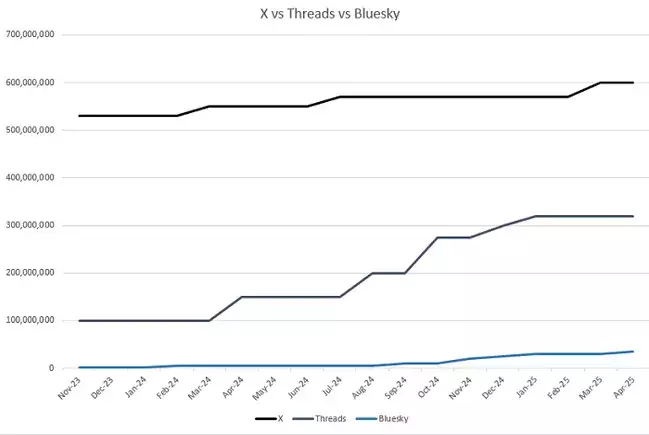In the ever-evolving landscape of social media, the competition has never been as fierce. As we near the two-year mark since the launch of Threads, discussions have intensified regarding its growth trajectory in comparison to established platforms like X (formerly Twitter) and the emerging contender Bluesky. The interplay of user engagement, growth rates, and strategic pivots creates an exhilarating atmosphere ripe for analysis. Several indicators suggest that Threads is positioning itself for a major breakthrough, drawing attention away from legacy platforms like X, which, despite its extensive user base, seems to be experiencing stagnation in growth.
Threads: A Meteoric Rise
Threads launched in July 2023 and has shown remarkable growth momentum since its inception. As of now, it boasts 320 million monthly active users—a figure that continues to climb steadily. Predictions indicate that it may surpass 400 million users this year, which would signify a significant achievement in merely 20 months. What’s more compelling is the rate at which Threads is acquiring new users. The application’s user base has expanded by a staggering 200 million over the past year, indicating a voracious appetite for its offerings.
This aggressive growth is not merely a product of novelty; Threads has strategically positioned itself to capture attention in the realm of real-time sports discussions and breaking news. As sports conversations have historically dominated X, Threads’ pivot toward this and other timely content streams makes it a relevant player in the space, drawing in users eager for immediate updates.
X: A Platform in Stasis
In stark contrast, X’s growth appears to be flattening significantly. Despite claiming a user base of 600 million, the platform has only seen an increase of about 50 million users over the past year. This sluggish pace raises questions about its long-term viability and user satisfaction. While it still retains a sizable audience, its inability to add new users at a meaningful rate signals potential pitfalls ahead.
As a platform that was once the go-to for real-time commentary and public discourse, the decline in engagement could be attributed to several factors, including conflicting usage data shared by its leadership and a growing dissatisfaction among users concerning its overall experience. This transparency—or lack thereof—creates uncertainty about the metrics X publishes, making it challenging to gauge its true position in the market.
Bluesky: A Contender with Slower Growth
While Bluesky has enjoyed a growth spurt, jumping from 5 million users in February last year to 35 million today, its momentum appears to have peaked. The platform added 5 million users during the first four months of this year, but this figure pales in comparison to the previous explosive growth, when it gained 5 million per month for four consecutive months. Though it remains a player in the narrative, Bluesky currently lacks the momentum necessary to disrupt the burgeoning rivalry between Threads and X.
Yet, the unique approach of Bluesky—focusing on decentralization—offers a compelling alternate vision for social networking. The smaller user base may still evolve into a dedicated community that could unexpectedly capture larger market shares if either Threads or X stumble.
The Future: An Unpredictable Landscape
Ultimately, the tussle between Threads and X shapes the future of real-time social media. Amidst current trends, Threads appears to have the upper hand, especially with its user growth rate significantly surpassing that of X. However, the landscape is unpredictable; market dynamics can shift rapidly. If Threads continues to capitalize on its accelerated user base and strategically focus on topics that resonate with audiences, it may soon displace X as a leader.
Moreover, the success of Threads is not guaranteed. If Meta, its parent company, miscalculates key aspects of user engagement or community building, it might lose its foothold. The lessons learned from past missteps in social platforms indicate that continuous adaptation and understanding user needs will be critical factors in determining who ultimately reigns supreme. Users crave authentic engagement, and the platform that best meets this desire will find itself not just participating in the competition but leading it. The race is far from over, but the stakes have never been higher.


Leave a Reply